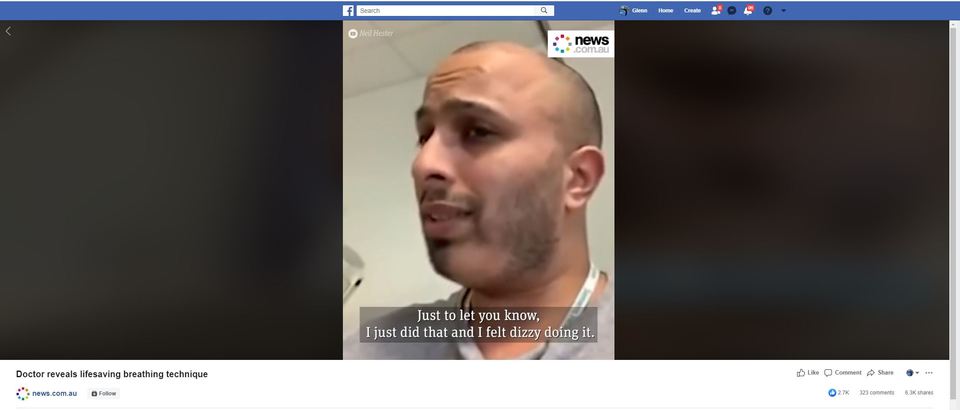This is the Active Cycle Breathing Technique (ACBT), an exercise often given to people with respiratory disorders like pulmonary fibrosis, bronchiectasis and cystic fibrosis. It is prescribed to help shift stubborn mucus deep within the lungs. It is so widely prescribed that I may potentially get myself offside with some respiratory physiotherapists with this response. However, in 17 years of clinical experience I have regularly seen the damage daily practice of this exercise can do and the recovery possible when we take a very different approach which effectively involves doing the opposite.
ACBT involves ‘deep’ breaths which may constitute an increase in tidal volume (breath size) by as much as 200%. It can have the unfortunate consequence of increasing airway trauma and generating just as much, if not more, mucus than it dislodges. Due to the blood gas imbalance created, it can also produce states of transient hypoxia and many people doing this exercise will report sensations of light-headedness, as Doctor Sarfaraz Munshi, in the video, experiences after doing one cycle. The approach I and my colleagues use in our clinics to improve breathing and oxygenation and to help dislodge mucus, is gentle breathing exercises and guidelines that help restore a more functional breathing pattern.
ACBT Case Study: There is a better way
To describe one of many relevant case studies, I saw a client with bronchiectasis just before the lockdown. She had been prescribed Anoro Ellipta. This medication, commonly prescribed for COPD, contains two types of bronchodilators: umeclidinium bromide, a long-acting muscarinic antagonist and vilanterol, a long acting beta agonist. She had also been prescribed Q-Var (beclomethasone dipropionate), an extra-fine inhaled corticosteroid. In addition, she was instructed to do the ACBT three times a day.
She had been an otherwise fit 77-year-old and an active golfer until contracting a respiratory infection in September 2018. Since that time, her condition had deteriorated to such a degree that she was almost constantly coughing, fatigued and no longer able to golf. After an initial breathing assessment which included capnography, I enrolled the client in a six-week breathing retraining programme. The programme consists of five 90-minute group sessions and one private follow-up session, again including capnography. Clients are taught breathing exercises that focus on restoring a functional breathing pattern (rate, rhythm, volume, mechanics, use of the nose), for all situations (awake, asleep, at rest, during eating, speech and exercise).
A week into the course the client’s respiratory specialist agreed to discontinue the Anoro Ellipta. The Q-Var dose was unchanged. She stopped the ACBT and started breathing exercises that focus on instruction to nasal breathe, if possible, and to breathe at the lowest volume comfortable. The rationale is to reduce airway trauma and to restore humidity and the optimal balance of oxygen, carbon dioxide and nitric oxide in airways. Functional breathing in this way also helps reduce both the production and viscosity of mucus. With less mucus produced, it is easier to clear and usually, without the need to cough. Nasal breathing helps raise the level of nitric oxide, a potent germicide, produced in the paranasal sinuses. Most importantly the reduced breathing volume allows the airways to begin the healing process.
Progress at day 24: almost no coughing since day 5 and the client reports her energy has returned. Breathlessness has reduced to such a degree that she has been able to go back to her daily walks. Her only regret is that now with the lockdown she is unable to get to the golf course.
Better Breathing: What we advise
It is the experience of myself and my colleagues, both in NZ and internationally, that clients have made rapid improvements just by stopping daily practice of the ABCT exercise and learning to breathe functionally. This includes instruction to nasal breathe at all times, if possible, and to breathe at the lowest volume comfortable.
Guidelines are to maintain comfortable nasal breathing up to moderate levels of exertion and to reduce the pace and intensity, if necessary to achieve this.
ABCT is poorly tolerated by people with respiratory disorders and possibly exacerbates disease progression. Sadly, this well-meaning UK doctor could be responsible for a great deal of harm. The advice to slow down and discourage deep, big volume breaths fits with research on the treatment of acute respiratory distress syndrome where it has been demonstrated that mechanical ventilation at lower tidal volumes leads to better outcomes in both morbidity and mortality. In other words, lower tidal volumes save lives and reduce airway damage.
Finally, a plea to health professionals working with respiratory disorders to consider that when it comes to breathing, less is more.



